Garlands bearers, typically in the form of small naked putti holding up a continuous garland very large in relation to their size, formed a popular ornamental design in classical arts, from the Greco-Roman world to India, with ramifications as far as China. In Europe they were revived in the Renaissance, and continued in later periods.
Greco-Roman art
The garland-bearer design was extremely popular in the Mediterranean.[1] It first appeared at the end of the Hellenistic period, and its popularity expanded during the Roman period.[1] The design reached a peak of popularity in the 2nd century CE, adorning sarcophagi made in Asia Minor to be sold in Rome.[1]
Greek garland bearer designs tend to be continuous, and the garlands are furnished with leaves and stems.[1] Roman garland bearer designs are segmented and often use flowers and fruits for decoration.[1]
Garland bearers were also particularly associated to the cult of Dyonisos.[2]
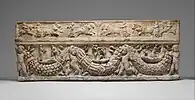 Garland bearers on a Roman sarcophagus, 130-150 CE.
Garland bearers on a Roman sarcophagus, 130-150 CE. Greco-Roman garland bearers, Rockefeller Museum
Greco-Roman garland bearers, Rockefeller Museum Garland bearers on a sarcophagus, in Aphrodisias.
Garland bearers on a sarcophagus, in Aphrodisias..jpg.webp)
Central Asia
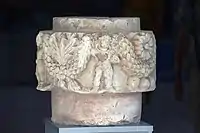 Capital with a figure showing features of Buddha and Heracles (100-200 CE), Old Termez Archaeological Museum.
Capital with a figure showing features of Buddha and Heracles (100-200 CE), Old Termez Archaeological Museum.
Indian art
The erotes or putti holding garlands is one of the most common motif of the Greco-Buddhist art of Gandhara.[1] According to John Boardman, they find their origin in Hellenistic designs, rather than Roman ones.[1] The garlands had an important role in decorating Buddhist stupas.[4]
 Yakshas holding Garlands, Peshawar Museum.
Yakshas holding Garlands, Peshawar Museum. Garland and amorini, Gandhara, c. 2nd-3rd century CE
Garland and amorini, Gandhara, c. 2nd-3rd century CE Garland bearers and Romaka Jataka (25-50 CE), Mathura Museum
Garland bearers and Romaka Jataka (25-50 CE), Mathura Museum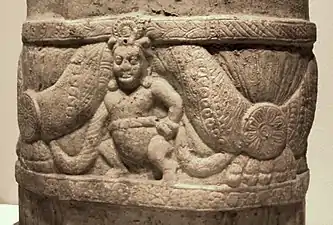 Yaksha holding a garland, Amaravati stupa.
Yaksha holding a garland, Amaravati stupa.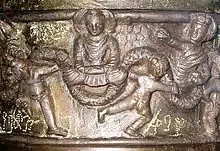 Erotes, garland and the Buddha on the Kanishka casket
Erotes, garland and the Buddha on the Kanishka casket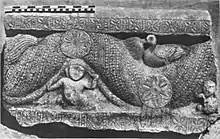 Limestone coping fragment, Ter, Maharashtra.
Limestone coping fragment, Ter, Maharashtra. Garland bearers, Amaravati stupa, India. Chennai Government Museum
Garland bearers, Amaravati stupa, India. Chennai Government Museum
China
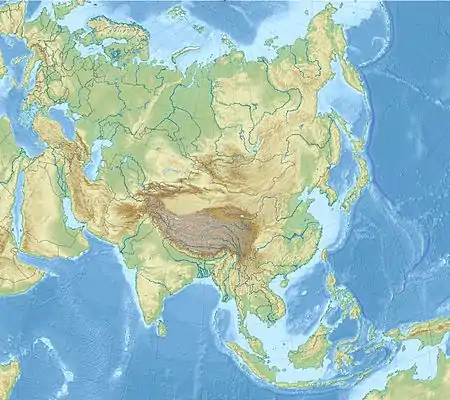
The garland bearer design can be seen in Buddhist frescoes in Miran, China, from the 3rd century CE.
References
- 1 2 3 4 5 6 7 Ladislav, Stančo (2012). Greek Gods in the East. Charles University in Prague, Karolinum Press. p. 116. ISBN 978-80-246-2045-9.
- ↑ Boorstin, Daniel J. (2012). The Creators: A History of Heroes of the Imagination. Knopf Doubleday Publishing Group. p. 203. ISBN 978-0-307-81721-1.
- ↑ Yi, Joy Lidu. The Global Connections of Gandhāran Art. p. 56.
- ↑ "The garland is a very significant ornament used for the purpose of decoration on the stupas by the devotees. The devotees who carry garlands are called the 'garland-bearers'" Proceedings volume of the 18 th Annual Conference. South Indian Historical Congress. 1999. p. 342.
.jpg.webp)



_(14782860032).jpg.webp)
_(14803067223).jpg.webp)
